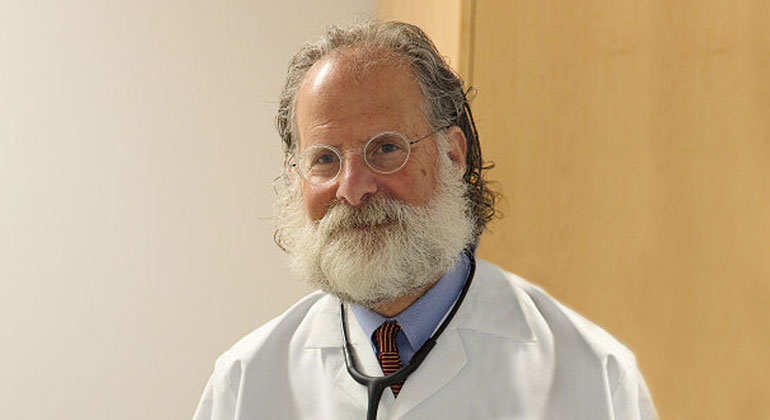
A Mount Sinai Cardiologist’s Colleagues Save His Life
William J. Schwartz, MD, Clinical Director of Ambulatory Cardiology at Mount Sinai Queens and Assistant Professor of Medicine (Cardiology) at the Icahn School of Medicine at Mount Sinai, gave an accidental pop quiz to his medical team when he had his own cardiac emergency. Fortunately for everyone, they passed with flying colors.
It started one evening in March 2022, when Dr. Schwartz started to feel uncomfortable and achy in his chest, back, and shoulders, while walking to his car after work at Mount Sinai Queens. His first thought was that he had caught his wife’s bad cold. As the evening progressed, his discomfort persisted.
Dr. Schwartz, 71, didn’t have the standard risk factors for a heart attack. He didn’t smoke, have high blood pressure, diabetes, high cholesterol, or a family history of heart disease. He led an active lifestyle, running five miles weekly on a treadmill without feeling any shortness of breath or chest pain. Yet, something made him think, “heart.” Around midnight, he decided to take himself to the Emergency Department (ED) at The Mount Sinai Hospital.
When Dr. Schwartz arrived at the ED, they took an electrocardiogram (EKG), a test that can identify an acute heart attack. His EKG looked suspicious but not alarming. Blood tests were sent, and he was admitted to the ED for observation. An hour later, Dr. Schwartz started to feel much, much worse. “It felt like the inside of my chest was being pulled out of my body,” he says.
He signaled the staff, who immediately carried out a second EKG. The second EKG showed a different result than the first. It revealed that Dr. Schwartz was having a heart attack due to a complete blockage of one of his heart’s arteries. His pain reflected dying heart tissue, and he was at risk of sudden cardiac death. This condition is known as an ST elevation myocardial infarction, or STEMI, which requires an emergency procedure called cardiac catheterization."
The ED staff notified the Cardiology STEMI team, which consists of doctors, nurses, and technicians rotating on call 24/7 to perform emergency catheterizations.
Dr. Schwartz was then rushed to the Cardiac Catheterization Laboratory (Cath Lab), which is equipped with specialized imaging equipment designed to diagnose and treat heart problems. On arrival to the Cath Lab, Dr. Schwartz was met by his colleague, now his treating physician, Raman Sharma, MD, Assistant Professor of Medicine (Cardiology) at Icahn School Mount Sinai and Assistant Director of Endovascular Intervention at The Mount Sinai Hospital, and the Cath Lab team.
“Once someone is having a STEMI, you basically have 90 minutes to treat it,” says Dr. Sharma. “Whether the patient is homeless or the President of the United States—or a colleague like Dr. Schwartz—we do the same emergent procedure to revascularize in a timely manner. We didn’t do anything special because Dr. Schwartz was a colleague.”
“TV shows used to show someone who was having a heart attack grabbing their chest and falling down to the ground,” Dr. Sharma says. “But that’s not how most heart attacks present these days. Nowadays, a lot of people say they’ve been feeling kind of funny for a few days, off and on. Then, all of a sudden, they get this huge pressure in their chest.” When this happens, says Dr. Sharma, the key is not to just go to sleep and hope to feel better in the morning. “You should go to the ER, like Dr. Schwartz did.”
Dr. Sharma performed an angiogram, which showed the totally blocked artery. He inserted a small mesh tube called a stent to unblock the artery and essentially “stop” the heart attack. “This is the standard approach for a STEMI,” explains Dr. Sharma. It was an uncomplicated procedure and required only one stent.
"For Dr. Schwartz, opening the artery with the stent resulted in immediate relief of his pain. Following the catheterization, Dr. Schwartz was brought to the Cardiac Intensive Care Unit (CICU). The next day, recovering in the CICU, Dr. Schwartz had a brief episode of mild chest pain. The EKG was normal. The first angiogram had revealed a second, less significant blockage. Given his further symptoms, the team advised that the other blockage should also be treated."
The next morning, Dr. Schwartz went back to the Cath Lab. Annapoorna S. Kini, MD, Interventional Director of Mount Sinai’s Structural Heart Program and the Zena and Michael A. Wiener Professor of Medicine at Icahn Mount Sinai, placed a second stent. This procedure also went smoothly, and Dr. Schwartz was discharged that evening,
Four months later, Dr. Schwartz danced at his son’s wedding.
Since his STEMI, Dr. Schwartz has become even more appreciative of his life and health. In his cardiology practice, he often shares his story with his colleagues and his patients, reminding some, and informing others, that life-threatening heart disease may not be preceded by typical risk factors or symptoms.